Olga's Gallery
During the past two months we've published collections of several artists
of the XX century, including Giorgio
de Chirico, Francis Picabia,
Marcel Duchamp, George
Grosz, Max Ernst, Jean
(Hans) Arp, Man Ray.
In the beginning of the century all of them actively participated,
and actually were founders, of the nihilistic movement in literature and
art called Dada, or Dadaism. The movement was based on the principles of
deliberate irrationality, anarchy, and cynicism and the rejection of laws
of beauty and social organization. It took form simultaneously during wartime
in different countries.
The aim of our today's newsletter is to attract your attention to its representatives in painting, whose collections we already have in the gallery.
Dada and Visual Arts
How the French child's word for a horse 'dada' gave the name for the artistic movement sounds like a historical anecdote. During the WW1 in Zurich an international group of the mind-like intellectuals, which included Hugo Ball, a German author, Richard Huelsenbeck, a German author (and later psychiatrist); Tristan Tzara, a Rumanian poet; Marcel Janco, a Rumanian painter; Jean (Hans) Arp (1887-1966), an Alsatian painter and sculptor; and Arp's future wife, Sophie Taeuber, Swiss artist and designer, founded the Cabaret Voltaire. "It is necessary to clarify the intentions of this cabaret," Hugo Ball wrote, "It is its aim to remind the world that there are independent men, beyond war and nationalism, who live for different ideals." (Cabaret Voltaire. Zurich, 1916). The legend says that while trying to find a name for their group, a paper knife was inserted into a French-German dictionary and pointed to the word dada. The participants liked the word and thought it appropriate for their anti-aesthetic works and protest activities against the war and the values of bourgeois society in general.
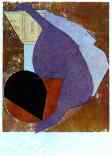 The
major figure in visual arts of the Zurich group was Jean
(Hans) Arp (1887-1966), a war exile from Germany. His works of about
1916 were exercises of principles in "continuous contradiction" and "immediate
spontaneity" (Tzara). Small pieces of paper were let to fall down freely
on a surface and then glued to it where they had fallen. Arp declared:
"The 'law of chance', which embraces all laws and is unfathomable like
the first cause from which all life arises, can only be experienced through
complete devotion to the unconscious." In 1930s, Arp abandoned Dada aims
altogether; his creations, which followed, the so-called sculpture-in-the-round,
were some abstract compounds, which he insisted were "autonomous and natural
forms".
The
major figure in visual arts of the Zurich group was Jean
(Hans) Arp (1887-1966), a war exile from Germany. His works of about
1916 were exercises of principles in "continuous contradiction" and "immediate
spontaneity" (Tzara). Small pieces of paper were let to fall down freely
on a surface and then glued to it where they had fallen. Arp declared:
"The 'law of chance', which embraces all laws and is unfathomable like
the first cause from which all life arises, can only be experienced through
complete devotion to the unconscious." In 1930s, Arp abandoned Dada aims
altogether; his creations, which followed, the so-called sculpture-in-the-round,
were some abstract compounds, which he insisted were "autonomous and natural
forms".
In the United States, Dada-like activities arose independently and actually a year earlier than those in Zurich, which gave the movement its name. If in Europe it was mainly a literary movement, in America it was started by visual artists such as an American Man Ray (1890-1977), a Frenchman Marcel Duchamp and his compatriot Francis Picabia (1879-1953). The movement was centered in New York at Alfred Stieglitz's gallery, his magazine "291," and at the studio of the Walter Arensbergs.
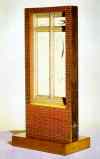 The
most enigmatic Dada intellectual and a primary innovator was Marcel Duchamp
(1887-1968), one of the legendary figures of the 20th century art. His
works are difficult to call art (sorry, we have "bourgeois" tastes, which
the Dadaists detested –author) and the primary aim of all his exercises
was to "challenge audience preconceptions about art and taste." He achieved
his aims, and though on the whole it was and "infantile rebellion" his
works gave an impulse for the further development and search in visual
arts, aesthetics and theory of art, especially in the USA. His discoveries
in the sphere of fantasy were used by the Surrealism, the new artistic
movement born by Dada. Though most of the Dadaists became gradually the
Surrealists or were interested in other artistic movements, Duchamp remained
a true Dadaist to the end.
The
most enigmatic Dada intellectual and a primary innovator was Marcel Duchamp
(1887-1968), one of the legendary figures of the 20th century art. His
works are difficult to call art (sorry, we have "bourgeois" tastes, which
the Dadaists detested –author) and the primary aim of all his exercises
was to "challenge audience preconceptions about art and taste." He achieved
his aims, and though on the whole it was and "infantile rebellion" his
works gave an impulse for the further development and search in visual
arts, aesthetics and theory of art, especially in the USA. His discoveries
in the sphere of fantasy were used by the Surrealism, the new artistic
movement born by Dada. Though most of the Dadaists became gradually the
Surrealists or were interested in other artistic movements, Duchamp remained
a true Dadaist to the end.
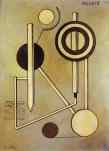 Duchamp's
friend, Francis Picabia (1879-1959), shared his taste for paradox, brainteasers
and public challenge. He took part in many movements of the 20th century,
including Neo-Impressionism, Cubism, Futurism, and Dadaism. His so-called
"mechanomorphs", the colored technical drawings, belong to his Dada period.
Duchamp's
friend, Francis Picabia (1879-1959), shared his taste for paradox, brainteasers
and public challenge. He took part in many movements of the 20th century,
including Neo-Impressionism, Cubism, Futurism, and Dadaism. His so-called
"mechanomorphs", the colored technical drawings, belong to his Dada period.
 The
third vivid figure in the New York Dada group was Man Ray (1890-1977).
He was mainly a photographer. A tireless experimenter in form, he invented
Rayographs, a type of cameraless photography; by putting objects directly
on sensitized paper and exposing them to light he got interesting abstract
patterns. Man Ray also created paintings of fantastic content and made
his contribution in Dada's ready-mades, e.g. Gift,
an iron the working surface of which is studded with tacks turned outward,
making it absolutely non-usable; such a little sadistic joke.
The
third vivid figure in the New York Dada group was Man Ray (1890-1977).
He was mainly a photographer. A tireless experimenter in form, he invented
Rayographs, a type of cameraless photography; by putting objects directly
on sensitized paper and exposing them to light he got interesting abstract
patterns. Man Ray also created paintings of fantastic content and made
his contribution in Dada's ready-mades, e.g. Gift,
an iron the working surface of which is studded with tacks turned outward,
making it absolutely non-usable; such a little sadistic joke.
Between 1918 and 1920 Dada spread from Zurich into Germany. In Berlin,
Dada took its most explicit political form. Richard Huelsenbeck, one of
the founders of the Zurich Dada imported its ideas to Berlin, and started
a polemical attack on what he saw as "salon" Dada à la Tzara. Together
with Raoul Hausmann he drew up a program that was plainly different from
the Zurich movement's:
"Dadaism demands
1. the international revolutionary association of creative and intellectual
persons throughout the world in the spirit of radical Communism;
2. the introduction of incremental unemployment linked to wide-ranging
mechanization of every field of activity. Only unemployment assures the
individual of an opportunity to assess the truth of his own life and be
finally reconciled to experience;
3. the immediate expropriation of property (socialization) and Communist
food for all, and the creation of garden cities and cities of light, to
be the common property of all and to help mankind evolve towards freedom."
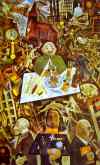 We
have chosen George Grosz (1893-1959),
painter and graphic artist, to represent Berlin Dada. His works of the
German period are a bitter satire on post-war Germany, fulfilled through
traditional means and forms of artistic expression.
We
have chosen George Grosz (1893-1959),
painter and graphic artist, to represent Berlin Dada. His works of the
German period are a bitter satire on post-war Germany, fulfilled through
traditional means and forms of artistic expression.
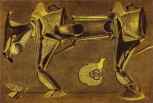 The
Cologne Dada group, dominated by Max Ernst
(1891-1976), was not so radically political and straightforward as their
Berlin colleagues, but scandalized the public by their 'junk' assemblages
and collages, the meaning of which the public failed to comprehend and
felt insulted. It was the Cologne Dada group, and mainly Max Ernst, which
hastened dramatically the transition from Dada to Surrealism.
The
Cologne Dada group, dominated by Max Ernst
(1891-1976), was not so radically political and straightforward as their
Berlin colleagues, but scandalized the public by their 'junk' assemblages
and collages, the meaning of which the public failed to comprehend and
felt insulted. It was the Cologne Dada group, and mainly Max Ernst, which
hastened dramatically the transition from Dada to Surrealism.
By the 1920s Dada came to its logical end, their postulation of nihilism and negating everything had brought them to negating themselves. The February 1920 Bulletin Dada proclaimed, "The real Dadaists are against Dada." (Modern Art. By Sam Hunter et al., NY, 2000, p.177).
On the ruins of Dada a group of Parisian intellectuals built up another artistic movement, Surrealism.
Bibliography:
Modern Art. By Sam Hunter et al. NY. 2000.
George Grosz. By Ivo Kranzfelder. Taschen. 2001
The
Dada Painters and Poets: An Anthology by Robert Motherwell
(Editor), Bernard Karpel, Jack D. Flam (Designer). Belknap Pr, 1989.
Dada
and Surrealism (Art and Ideas) by Matthew Gale. Phaidon Press
Inc, 1998.
Une
Semaine De Bonté: A Surrealistic Novel in Collage by
Max Ernst. Dover Pubns, 1976.
Blago
Bung, Blago Bung, Bosso Fatakal: First Texts of German Dada (Anti-Classics
of Dada) by Richard Huelsenbeck (Contributor), Walter Sterner,
Malcolm Green (Translator), Hugo Ball (Editor). Serpents Tail, 1995.
Dada:
Art and Anti-Art (World of Art) by Hans Richter, David Britt
(Translator). Thames & Hudson, 1997.
Flight
Out of Time: A Dada Diary (Documents of Twentieth Century Art)
by Hugo Ball, John Elderfield (Editor), Ann Raimes (Translator). University
of California Press, 1996.
Dada
Cologne Hanover: Crisis and the Arts the History of Dada (Crisis and the
Arts. Vol 3) by Charlotte Stokes (Editor), Stephen C. Foster
(Editor). G K Hall, 1997.
The
Dada Almanac (Atlas Arkhive, 1) by Richard Huelsenbeck (Editor),
Malcolm Green (Editor), Barbara Wright (Translator), James Kirkup. Consortium
Book Sales & Dist, 1994.